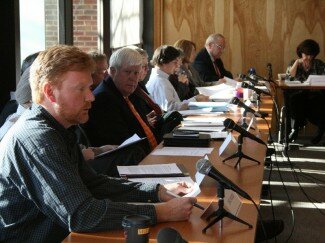Water panic: in giant confab, officials agree to study pipeline
published 3:32pm Sunday Nov 30, 2008
Rivanna Water & Sewer Authority chair Mike Gaffney opened an assemblage of four local governing bodies November 25, but it was Charlottesville Mayor Dave Norris who appeared to be steering the ship. Ever since Gaffney dodged a key pipeline issue and the City responded by unanimously demanding new data before it would agree to move forward on a controversial 50-year water plan, some pro-plan officials have been in a panic.
John Martin, for instance, considered at least part of the discussion “very frustrating.” A member of the Albemarle County Service Authority, Martin slammed the motives of plan detractors and challenged the Mayor to provide “factual basis” for demanding new information.
“I think we need to address the question whether government must be paralyzed just because someone doesn’t like the outcome,” said Martin, who was recently placed on a task force to study dredging the Rivanna Reservoir, and yet declared, at an early-September meeting of that body, that dredging to augment the local water supply is “off the table.”
And at Tuesday’s multi-board meeting, Martin indicated that he hasn’t budged. The task force, he said, may recommend that dredging should wait a decade— and even then might be undertaken merely to satisfy the UVA rowing team.
The plan has kept the community roiled in debate this year as details have emerged. It is now confirmed that it would clear-cut over 180 acres of forest, leave the two existing reservoirs to dwindle from siltation, would place a new reservoir around Interstate 64, and would fail to significantly increase drought-time water supply without an uphill pipeline that critics fear will experience a cost explosion like the one that struck the dam, whose price recently geysered to $90.1-107.4 million, a near tripling of the oft-repeated estimate of $37 million.
“In fairness,” Rivanna chair Gaffney told the 20 or so officials and approximately 100 spectators assembled inside the CitySpace, “very little has been written about a separate opinion by a second firm, Schnabel Engineering.”
Indeed, by quarrying gravel on the site of Ragged Mountain Natural Area, avoiding a construction-time safety measure called “coffer dams,” and using grout instead of deeper foundations to deal with fractured bedrock, Schnabel hopes to save at least $13.5 million. But even Schnabel leaves the dam more than double its original estimate and doesn’t address the mysteries of the uphill pipeline.
Currently, the pipeline is just a few pages of broad concepts, and already certain assumptions have raised eyebrows, such as electrical costs rising just 25 percent over 50 years, somehow removing sediments without the usual treatment chemicals— and the kicker— convincing all the property owners along its 9.5-mile route to give up parts of their yard for just $249,000, in total. (Consultants had originally hoped to gain free pipeline easements by piggy-backing most of the route along the planned Route 29 Western Bypass, a moribund and oft-reviled proposed roadway.)
“There’s no point in having a dam if you can’t fill it with water,” noted City Councilor Satyendra Huja.
“Big pipes are laid in cities all the time,” responded ardent water plan backer Sally Thomas, a member of the Albemarle County Board of Supervisors and chair of the dredging task force. Calling the official plan the “most environmentally friendly” and a “long-range bargain,” Thomas contended that because it would be pipeline-fed, the planned reservoir will last “almost forever.”
The Mayor, however, stuck to his guns. He blasted the pipeline for being “premised” on construction of the Bypass. And, taking a theme from a blistering memo by the County’s top water manager, Norris ripped current water conservation goals as “woefully inadequate.” And Norris wasn’t finished.
Perhaps emboldened by six pro-dredging neighborhoods, 481 petition signatures, three conservation organizations, and a wildly successful business person who branded the plan Charlottesville’s own “bridge to nowhere,” Norris went on. He slammed the Rivanna Authority’s prior dredging estimates— which put the cost as high as $223 million— as “dramatically over-inflated.”
And unlike Thomas and Martin, who have attempted to steer the dredging task force away from water supply dredging, Norris— whose government actually owns the Rivanna Reservoir as well as the land targeted for the new one— informed his county counterparts that valid reasons may exist for all the criticism. “People,” explained Norris, without naming names, “aren’t looking at alternatives.”
Two months ago, a business lawyer who teaches at UVA’s McIntire School of Commerce sent the mayor a letter reminding him that the Rivanna Authority has a contractual obligation to “maintain all dams and water production facilities at the reservoirs” and that the City can take back its reservoirs in the year 2012. Such unilateral rights weren’t voiced at the four-board meeting, but they seemed to hover over the proceedings in Norris’ bolder-than-usual attitude.
“You don’t want to hold up the 50-year water plan,” said an astonished-sounding County Supervisor David Slutzky.
“It would be irresponsible,” added Martin, “to plan a water supply on assumptions that the public will conserve. If you’re going to err, you’re going to err on over-supply.”
But in his push for new demand numbers, Mayor Norris wouldn’t be deterred. “Conservation,” he said, “is the cheapest, easiest, and best way to extend our water supply.”
Such talk seemed to worry even pipeline-skeptical County Supervisor Dennis Rooker, who asked Rivanna director Tom Frederick to chime in.
“You’ve asked a very important question,” said Frederick, “one that gets into the realm of legal advice.”
Frederick said that state and federal regulators, upon discovering that conservation might lower the official 2055 demand figure of 18.7 million gallons per day— double today’s usage— could revoke permits for the existing plan.
“There is a possibility,” said Frederick, “that you might have to start all over again.”
At the end of the two-and-a-half-hour meeting, the four bodies pushed the responsibility for conservation back onto the water sellers, the City of Charlottesville and the Albemarle County Service Authority. (It was noted at the meeting that both sellers currently lose about 15 percent of their treated water to pipe leaks, but it was also noted that both sellers offers customers $100 rebates to install low-flow toilets.)
The four bodies also voiced their support of a dredging study, affirmed the creation of a three-engineer panel to assess the two cost estimates on the dam, and agreed to spend up to $25,000 for a new study on the feasibility of the proposed pipeline.
Left apparently unchanged amid all this was the City’s November 3 demand that Rivanna study ways to trim demand and then recalculate the 50-year demand projections.
–last updated 12:31pm, December 1








Where does John Martin get off calling me a nut? I want to see this mussell he allegedly found at Buck Mountain. I want it sent to Va. Tech for testing. I want him to prove it was actually found at Buck Mountain.
Thank you Mayor Norris for saying that there is legitimate criticism of the Ragged Mt. project. All the opponents of the plan are trying to do is make sure that the community doesn’t waste a couple of hundred million dollars.
I have found that the idea of “Easy: Good; Complex: Bad” works best in nearly all system design situations. It doesn’t take an engineering degree or the ability to write a million dollar check to a consultant or two to realize that dredging is easier than creating a new dam and pipeline. The economic and environmental impact seems to be considerably less.
Yet for some reason certain members of the powers that be have stated that the easy option is off the table. My question is, why? Why the unwillingness to consider the easier option, the option that will have far less impact on our ecosystem? I think a few weeks ago we voted to reduce such intransigence.
Something to think about.
The current Community Raw Water Project, backed by RWSA and all the County Supervisors, appears to be a huge river conservation project cooked up by The Nature Conservancy (TNC). If you go on the RWSA website and search for “The Nature Conservancy” you get no hits. But if you go on TNCs web page and search for “rivanna” or “moormans” you get many hits, especially in their members only section.
TNC is a $6 Billion outfit. They operate in the stratosphere of power and influence. Treasury Secetary, Henry Paulson, author of the current “financial bail out program” is a recent past president. One large and growing program is the Freshwater Innative. It is based right here in Charlottesville and the co-leader is Brian Richter who calls The Moormans River “Home”. Mr Richter wrote a book titled “Rivers of Life”.
Personally, I enjoyed the book. It is a good and worthwhile read for any interested person. He has a plan to return rivers to “natural stream flow” and appears decidedly against reservoirs located in the stream flow of rivers and also the dams that create them. In the past he has worked with very large dams but now is targeting smaller watersheds.
Read the book, the the website http://www.nature.org/initiatives/freshwater/
then our permit to withdraw water from the Rivanna River. I think you will see that the plsn to allow the SFRR to fill with sediment and construct a new reservoir high up in The Ragged Mountains is a TNC plan, adolpted by RWSA. It will abandon approximately $150 Million of existing infrastructer and build about $200 Million new infrastructure.
There is nothing wrong with that except it should be known and transparent. And the water rate payers should know what is River Restoration and what is to avoid water shortage. Nobody can directly VOTE on this expenditure. All the members of the RWSA Board are appointed. None are elected. They have the sole power to spend the money, float the bonds and raise the water charges to service the debt. The only wat to change the program is to chance the individuals who appoint them.
The city and county are spending money to plant trees and reduce CO2 emissions, or so they say. The current plan requires about 52,000 large old trees to be cut and by letting all the water of Sugar Hollow to flow down the Moormans River just to be pumped back up again, leaves a huge CO2 footprint.
There are other alternatives but they don’t appear to fit the TNC criteria. Buck Mountain Reservoir was aparently discarded because of the presence of the James Spineymussel. Yew RWSA has never don the survey that the state requested to confirm this. Please notive that Buch Mountain would have been an “in-stream” reservoir.
And Expanding Sugar Hollor Reservoir (the best water we have) was omitted from serious study. Evidentially raising the dam would invade The National Parl land a extremely little bit. Yet nobody tried to negotiate with The Park Service and the 1/2 mile of fciyu owned land below the dam was ignored. Holding back much of the flood waters of Sugar Hollow would also reduce sedimentation transport to SFRR. But again please note that this is an in-stream reservoir.
Responsible River Restoration should be a priority for our community. But transparent, open government is required to preserve our way of life. I would be happy to share any thoughts and information I have.
Add Mayor Dave Norris to the growing list of champions for the people (along with Betty Mooney, Kevin Lynch, and others). How refreshing to see an elected official stand up for the citizens, and against the deep pockets and clout of the county.
Sorry, but the RWSA board has to go, especially the developer Mike Gaffney. Many people have lost any confidence in this board– too much has happened, and far too much has been uncovered. We need 100% transparency and accountability, and we need it NOW. There’s no way we can get that with the current board.
Once again, thanks to Mooney, Lynch, and Norris for looking out for the interests of all, not just the fortunate few.
I am sorry. I posted the draft version avove instead of the finished one. Oh well
Ditto to Follow the money and thanks to Richard Lloyd for his comments. It’s seems that Thomas has subtly and Martin has overtly buillied their will over a lot of “leaders.”
“Frederick said that state and federal regulators, upon discovering that conservation might lower the official 2055 demand figure of 18.7 million gallons per day— double today’s usage— could revoke permits for the existing plan.” This worth repeating and Thomas, as an elected official, should be made to write it ten times.
Sally, a wolf or fox in sheeps’ clothing???? She has been caught in the hen house!
Was disappointed to read the following today on the Charlottesville Tomorrow site:
“Councilor David Brown answered by saying that many neighborhood associations have approached the Council with their concerns over the rising cost of the dam, but he said their information may have been based on incomplete news reports.”
Can’t speak for any other neighborhoods involved, but we (Woolen Mills) considered all the facts before our Board voted whether or not to endorse Council’s resolution. Knowing many of the other neighborhood leaders though, I’d say, with confidence, that they did likewise. One has to consider each bit of data as it becomes public. Failure to adapt to new information is an incredibly foolhardy way to do business. Many of us had originally made decisions regarding the feasibility of the dam expansion based on the faulty info we had at that time. Now that we all know better, we need to do better.
This isn’t solely a City issue either. Many in the County are just as concerned about this pig-in-a-poke.
Brown will be challenged here. His comment is truly unbelievable.
“Councilor David Brown answered by saying that many neighborhood associations have approached the Council with their concerns over the rising cost of the dam, but he said their information may have been based on incomplete news reports.” I’m not surprised that David Brown thinks that it’s erroneous that the cost of the dam is rising. Did anybody hear him make a fool out of himself, trying to chastise Downing Smith at this past council’s meeting? He though that professionals such as Frederick of RWSA send out draft memos that mis-state their positions by leaving out words such as “not.” Why would Frederick send out a memo for someone to check for clarity if he hadn’t bothered to read it himself first? This isn’t the first issue that he has bowed to the county leaders and that’s why he is called Marionette Brown.